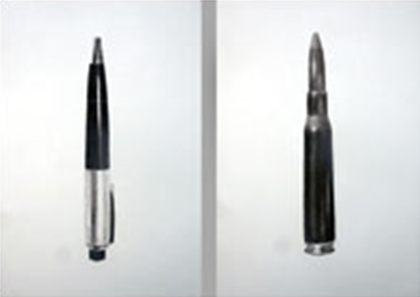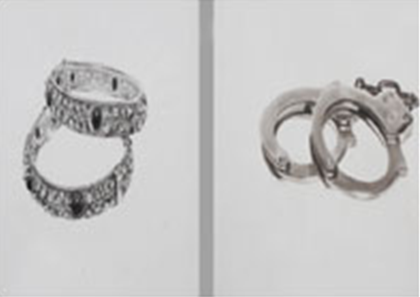Ayaz Jokhio
This is a collection of articles archived for the excellence of their content. Readers will be able to edit existing articles and post new articles directly |
Biographical details
Artnet and other sources
1978
Born: Mehrabpur, Sindh
1999
Best Poet of the Year Award from Sindhi Adabi Sangat, Mehrabpur. Sindh
Becamd a Studio assistant to Rashid Rana
2001
Graduated with a Bachelors in Fine Arts from the National College of Arts Lahore, Lahore,
A faculty member at BeaconHouse National University, School of Visual Arts, Lahore,
B
Ayaz Jokhio obtained his BFA (with distinction) from the National College of Arts, Lahore in 2001. He dissects the grammar of images with a certain intellectual logic and uses for his artistic works an amalgamation of imagery from print media, the Internet, and popular culture along with his own observations of contemporary Pakistan.
Jokhio uses installation, drawing, painting, and text to pose questions about the ways in which we regard and represent our world, often also commenting on the conventions of gallery display. His work has been shown in numerous group and solo exhibitions in Pakistan and abroad, and he has been a resident artist in Switzerland, Germany and Japan.
Ayaz Jokhio teaches at the Mariam Dawood School of Visual Arts and Design, Beaconhouse National University in Lahore.
Of his work for KB17 Ayaz Jokhio writes: “I never enjoy talking about or explaining my work. It is like explaining a joke, which makes no one laugh. This is the first time that I am trying to create an art piece with puppets. Puppetry has always been there in my heart, but always like a secret crush on someone. My installation for KB is an imitation of a common classroom setting in our public schools: students sitting in rows at their desks -- but replaced by marionettes/puppets. When someone opens the door and enters the classroom, all the puppets stand up like we all do during our student life in a classroom when a teacher or an elder enters. In my work, all the puppets are connected to the door through a mechanism of strings and pulleys. So basically when someone opens the door, it pulls the strings connected to the puppets and they all stand up. And when the door closes, the puppets all sit back down again. I have not followed the advice of many of my friends to make the puppets life-size, like real children. To me, they should be smaller than life so that they can look like puppets and not like real kids. Because the whole idea is to use puppets as a metaphor for what our educational system is trying to make out of our children.”
Ayaz Jokhio
So close, yet so far
By Salwat Ali
On the verge between art and documentary, ‘Ayaz Jokhio – Drawings’ on show at VM Gallery, Karachi plays with the objective and the accurate to accent the critical.
Large graphite/charcoal drawings, singular projections of ordinary, commonplace imagery, bound together and serialised as diptychs, draw attention to ‘similarities and differences’ inherent in images which may resemble each other physically but are far removed in meaning.
This twist, creating polarities, building contrasts with the intention of alluding to contemporary social, cultural and political conflicts, is essentially Jokhio’s thrust.
In the current mad rush for the new and the exciting, the known and the recognisable, is often ignored or pushed aside as too humdrum and banal. Concentrating on the very apparent and the very familiar, the artist invites the viewer to re-look and re-think the significances that can be accrued from the obvious. The diptych ‘Bullet:Pen’ projecting a mega image of a fountain pen on one side and a bullet on the other are almost alike in height, breadth and volume.
The tickler lies in the split in meaning. Through a deliberate, somewhat revised, replay of the common adage “the pen is mightier than the sword”, Jokhio prompts the viewer to bring new connotations to an old metaphor. The ‘Handcuff: Bracelet’ twosome, a pair of ornamental wrist adornments juxtaposed with a pair of bands for shackling prisoners, invites fresh musings on the issue of confinement at varied levels, symbolic, physical as well political.
Easy on the eyes and the imagination, Jokhio’s simplistic imagery is tweaked with humour as well. At times his equations are so direct and naive that one cannot help but be amused by his selection. The ‘Wrestler: Bomb’ diptych featuring a weighty sumo wrestler in attack mode alongside a heavy bellied atom bomb image is as funny as it is grave.
Essentially an exhibition of drawings, there is however no defining linear strength or brandishing strokeplay, pronouncing the artists individuality, in the works. Jokhio opts for a soft look. Creating tonalities with shading and blending, he has been successful in producing clean large drawings on pristine white paper.
When paper stubs and fingers are used to lay down and merge tones it is often difficult to maintain the crisp whiteness of the paper. Successfully managing this impediment, the artist has projected dramatic presentations that magnify his otherwise basic/ordinary picture making skills which while realistic in appearance are far removed from ‘realism’ as such.
Today the term ‘realism’ is next to meaningless in that it is used as a shorthand expression for everything from photo-realism to all manner of kitschy art. And while they all owe some degree of descendency from Realism, they are pretty far removed from what the original movement was and what it meant. In current usage Contemporary Realism advocates a simple realistic painting style. The artists of the genre come from various backgrounds but are united in their choice to depict their subjects accurately, rather than conform to the more abstract movements popular in Modern art. Contemporary Realists choose subjects from daily life but it is the critical and ideational aspect that determines their choice and use of imagery.
By creating simplistic mildly critical visuals that address current issues, Ayaz Jokhi’s rudimentary realism relates to the contemporary manifestation.
As an artist Jokhio relishes change and enjoys the excitement of discovering and crafting novel presentations. His literary grounding enables him to question existing reality and produce art that challenges the norms but he has yet to produce work that requires deeper engagement, stylistically and conceptually. The sensibility and potential to handle the technicalities seems to be there — he just needs to apply himself more seriously.
A 2001 graduate of NCA, Ayaz Jokhio has availed fellowships and awards from the Arrus Project Moriya, Japan and from Akademie Schloss Solitude, Stuggart, Germany where he also held solo exhibitions of his work. His current solos in Pakistan including the VM exhibition have been arranged by the virtual gallery Grey Noise.
Easy on the eyes and the imagination, Jokhio’s simplistic imagery is tweaked with humour


